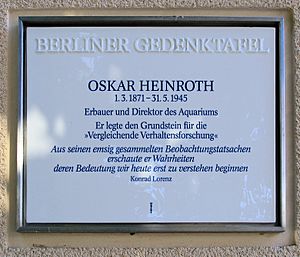Oskar Heinroth facts for kids
Quick facts for kids
Oskar Heinroth
|
|
|---|---|
 |
|
| Born | 1 March 1871 Mainz, Germany
|
| Died | 31 May 1945 (aged 74) Berlin, Germany
|
| Known for | Applying methods of comparative morphology to animal behavior |
| Spouse(s) | Magdalena Heinroth née Wiebe, Katharina Heinroth née Berger |
| Scientific career | |
| Fields | Pioneering ethologist |
| Institutions | Berlin Aquarium |
| Influenced | Konrad Lorenz, Niko Tinbergen |
Oskar Heinroth (born March 1, 1871 – died May 31, 1945) was a German biologist. He was one of the first scientists to study animal behavior in a new way. He compared how different animals acted, much like comparing their body parts. This made him one of the founders of ethology, which is the scientific study of animal behavior. Heinroth worked at the Berlin Aquarium. He cared for fish, reptiles, and birds, especially ducks and geese.
Contents
Oskar Heinroth's Early Life and Career
Oskar Heinroth was born in Mainz-Kastel, Germany. He first studied medicine and finished his degree in 1895. Later, he decided to study zoology, which is the study of animals. He did this while working at the Zoological Garden and the Natural History Museum in Berlin.
Expeditions and Aquarium Work
In 1900, Heinroth joined an expedition to the Bismarck Archipelago. This is a group of islands in the Pacific Ocean. He served as a zoologist on this trip. In 1904, he became an assistant at the Berlin Zoological Garden.
In 1911, Heinroth became the director of the Berlin Aquarium. He held this important job for over 30 years. He was very dedicated to his work with animals.
Family Life
Oskar Heinroth married Magdalena Wiebe (1883–1932). She also loved animals and was skilled at preparing animal specimens. After her death, Heinroth married Katharina Berger in 1933. Katharina was also a scientist who studied reptiles. She later became the head of the Berlin Zoo after World War II. Oskar Heinroth passed away in Berlin on May 31, 1945.
Contributions to Animal Behavior Studies
Oskar Heinroth made many important discoveries about animal behavior. He focused a lot on ducks and geese, which belong to a family called Anatidae. He believed that many of their natural behaviors and body features were connected to how they lived.
Understanding Instincts
Heinroth suggested that the bright patterns on ducks' wings might help guide flocks when they fly. He also noticed that male ducks with different looks often had more than one mate. He studied how ducks behaved, including hybrid ducks (mixes of different types). He thought that their behaviors could help scientists understand how different duck species were related.
Heinroth also observed that chickens seemed scared of birds with long tails and short necks. He thought this was because these were features of birds of prey. Later, famous scientists like Konrad Lorenz and Niko Tinbergen studied this idea more deeply.
Rediscovering Imprinting
Heinroth also rediscovered something called imprinting. This is when a young animal quickly learns to recognize and follow the first moving object it sees, usually its mother. This idea had been noted before but not fully explored. Konrad Lorenz, who was a student of Heinroth, helped make Heinroth's findings well-known.
Heinroth was the first to use the word "ethologie" (ethology) in the way we understand it today. He used it in his 1910 work about the biology and behavior of ducks. Many scientists, including Lorenz, considered Heinroth to be the true founder of the scientific study of animal behavior. Lorenz also said that Heinroth created an important way to understand the natural instincts of birds.
See also
 In Spanish: Oskar Heinroth para niños
In Spanish: Oskar Heinroth para niños


